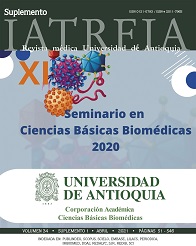Clinical, immunologic and genetic characterization of Colombian patients with cutaneous recalcitrant warts
DOI:
https://doi.org/10.17533/udea.iatreia.345515Palabras clave:
verruga, verruca, verrucae, warts, resistant, recalcitrant, WES, HPVResumen
Inborn errors of innate and intrinsic immunity are monogenic diseases that result in predisposition to a whole spectrum of infectious diseases (for example, viruses)(1). Cutaneous warts caused by Human Papillomavirus (HPV) infection has an incidence that range from ~10% in the general population(2). These lesions are relatively common and most warts regress spontaneously. However, in some individuals, these warts persist for > 2 years without response to conventional therapy (cryotherapy, salicylic acid or bleomycin), and they are called recalcitrant warts (RW)(2-4). Host defense against HPV relies on intact and functioning cellular immunity including T cell, natural killer cell cytotoxicity and intrinsic immunity. Therefore, in patients in whom warts are recalcitrant, concern for immune defects is raised (5).
RW have been documented in patients with a few inborn errors of immunity, either in combination with broad infectious phenotypes (combined immunodeficiencies), and HIV+ and transplanted patients(6, 7). On the another hand, is well documented that patients with Epidermodysplasia Verruciformis present a specific genetic predisposition to beta-HPV infection, but only very few is known about genetic susceptibility to recalcitrant warts and to our knowledge there is not studies searching for monogenic defects associated with RW(7-9). Therefore, we hypothesized that susceptibility to RW due to HPV viruses in otherwise healthy individuals, might be due to underlying genetic defects in intrinsic and innate immunity.
Descargas
Citas
(1) Tangye SG, Al-Herz W, Bousfiha A, Chatila T, Cunningham-Rundles C, Etzioni A, et al. Human Inborn Errors of Immunity: 2019 Update on the Classification from the International Union of Immunological Societies Expert Committee. J Clin Immunol. 2020;40(1):24-64.
(2) Leung L. Recalcitrant nongenital warts. Australian Family Physician. 2011;40(1-2):40-2.
(3) MASSING AM, EPSTEIN WL. Natural history of warts. A two-year study. Arch Dermatol. 1963;87:306-10.
(4) Scheurer ME, Tortolero-Luna G, Adler-Storthz K. Human papillomavirus infection: biology, epidemiology, and prevention. Int J Gynecol Cancer. 2005;15(5):727-46.
(5) Stanley M. Immune responses to human papillomavirus. Vaccine. 2006;24 Suppl 1:S16-22.
(6) Cubie HA. Diseases associated with human papillomavirus infection. Virology. 2013;445(1-2):21-34.
(7) Leiding JW, Holland SM. Warts and all: human papillomavirus in primary immunodeficiencies. J Allergy Clin Immunol. 2012;130(5):1030-48.
(8) Kalinska-Bienias A, Kowalewski C, Majewski S. The EVER genes - the genetic etiology of carcinogenesis in epidermodysplasia verruciformis and a possible role in non-epidermodysplasia verruciformis patients. Postepy Dermatol Alergol. 2016;33(2):75-80.
(9) de Jong SJ, Créquer A, Matos I, Hum D, Gunasekharan V, Lorenzo L, et al. The human CIB1-EVER1-EVER2 complex governs keratinocyte-intrinsic immunity to β-papillomaviruses. J Exp Med. 2018;215(9):2289-310.
Descargas
Publicado
Cómo citar
Número
Sección
Licencia
Derechos de autor 2021 Universidad de Antioquia

Esta obra está bajo una licencia internacional Creative Commons Atribución-NoComercial-CompartirIgual 4.0.
Los artículos publicados en la revista están disponibles para ser utilizados bajo la licencia Creative Commons, específicamente son de Reconocimiento-NoComercial-CompartirIgual 4.0 Internacional.
Los trabajos enviados deben ser inéditos y suministrados exclusivamente a la Revista; se exige al autor que envía sus contribuciones presentar los formatos: presentación de artículo y responsabilidad de autoría completamente diligenciados.














